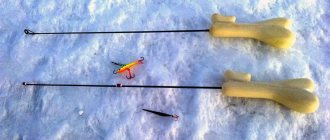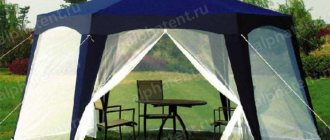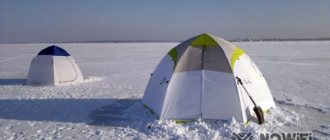Choosing a tent for a winter overnight stay
There are many types of winter tents on sale. They can be divided into two large groups:
- automatic;
- frame.
The machines are quick to assemble and disassemble, but the design is short-lived and unstable in the face of strong winds. If you buy them, you should pay attention to the manufacturer’s brand. When installing, you will need to not only insulate the tent yourself, but also secure it to the ice using metal pegs with beveled corners or screws.
Frame ones are more reliable, although it is more difficult to install them yourself. Such products are recommended for winter parking. When purchasing, pay attention to several parameters:
- The material should be quite dense, but breathable. Artificial fabric does not allow air to pass through, which will cause the accumulation of not only moisture, but also carbon dioxide. Therefore, when assessing this indicator, you need to pay attention to vapor permeability.
- The color of the product is light. Dark reduces the light level, so it will be uncomfortable inside.
- The tent should have a bottom - then it will be easier to insulate it with your own hands.
- Dimensions of the structure: the smaller, the better it retains heat. Typically, products of 150*150, 200*200 cm are chosen. It is important to evaluate the dimensions when folded. The design should fit into a hiking backpack.
- Shape: round is considered more stable, although a square tent can be securely strengthened with your own hands.
- Frame: metal is stronger than plastic. But the price difference will be significant. If you use a tent in open areas (where the wind constantly blows), it is preferable to choose a metal one.
- Fastenings: a more reliable option when the extensions are fixed to the arches. If they are attached tightly to the material, then you can expect the structure to break.
- The doors must have 2 locks with zippers: internal and external.
Advice! When choosing a tent, you need to pay attention to the presence of windows, pockets, hooks, hangers, and other additional elements that you cannot make with your own hands.
A winter tent should not be too bulky
DIY tent
In the absence of the necessary material resources, you can make a tent yourself. For the base of the tent, a regular fishing box, which can be purchased at the store, is suitable. You will also need:
- two pairs of children's skis: one is the smallest, the other is 160 cm;
- ski pole tubes;
- cot;
- tarpaulin.
At first glance, such a device seems not entirely clear, but it is very effective and convenient to use. The result is a box that can be transported on skis and a lightweight design for a small tent that can also be moved across the ice using skis. The only negative of the resulting product is its small size, but the size of the frame can always be adjusted. A tent frame is made from aluminum tubes from ski poles.
The upper nodes, which should connect the ribs of the tent, are equipped with cylinders whose thickness matches the diameter of the tubes. The bottom of the vertical tubes is attached to the skis. The frame of the tent is connected to the box using two tubes from the folding bed and round eyes. Now all that remains is to pull up the awning. To do this, metal plates are installed on the lower edge of the fabric, through the holes of which staples are passed.
https://youtube.com/watch?v=mkyYXXrFfDI
Choosing a place to set up a tent
When parking in the cold season, it is important not only to insulate the structure well with your own hands, but also to choose the right place and secure it. This is easy to do if you know some rules:
- If there is a prevailing wind direction, then the entrance should be located on the opposite (leeward) side.
- If the tent is square, then you need to position it with your own hands so that the main wind flow blows at the corner, i.e. she should stand with a wedge towards him.
- If possible, the structure should be placed in an area protected from the wind (near a hill, trees).
- When installing it yourself, the underskirt is fixed with stones and heavy objects. You can throw in a lot of snow. Experts do not recommend freezing, because then it is difficult to assemble the shelter.
Attention! If there are trees or old buildings nearby, it is necessary to position the structure as far as possible from them.
Materials for insulating a winter tent
There are several popular winter tent insulations that you can install yourself. For these purposes use:
- isolon;
- penofol;
- blanket;
- padding polyester with foil;
- batting;
- felt;
- travel rugs;
- thick polyethylene film;
- polyethylene foam;
- Oxford fabric and others.
TOP 10 best materials for insulation
Based on reviews from lovers of extreme sports and technical indicators, a rating of the 10 most effective insulating materials was compiled.
Izolon as the main insulation
Izolon
For winter overnight stays in a tent, you need high-quality specialized insulation. One of these is isolon or analogues, which can be purchased at a hardware store. This is an artificial material with excellent thermal insulation and a long service life. It is not subject to rotting and is easy to use (due to its plasticity). The minimum thickness is 2 mm. Izolon is made of foamed polymer material coated with foil.
Penofol
Sheet penofol for insulation
An analogue of isolon is penofol. An additional benefit is reflectivity. Both materials have one drawback - high price.
Sintepon with foil
Sintepon on foil
A rescue blanket or synthetic winterizer coated with foil is another material for insulating winter tents. For a small campsite, one blanket is enough; for a large campsite, you will need several.
When installing insulation, ventilation holes should be left open. This will protect against the formation of condensation on the internal walls of the room.
Batting
Batting fabric retains heat well.
Using this budget material, it is possible to insulate a tent tolerably well. It is recommended to fasten foil over the batting (it is better to use a stapler). The result is a fabric with reflective properties. The foil layer should be adjacent to the tent so that the heat emanating from the human body and the heating device does not escape outside.
Felt
Felt is the best insulation
You can insulate the floor using thick felt. The material is not difficult to transport in vehicles, since it folds and does not take up much space. The insulation is laid in several rows. Heating of the room occurs due to wool pile.
With prolonged use of felt flooring, puddles may form under it from melting ice and snow. Therefore, when installing, polyethylene must be laid underneath.
Polyethylene film
Polyethylene
To prevent heat loss inside, when insulating, make a second layer of dense polyethylene film. If you cover it from above, you will be guaranteed protection from strong winds and wet snow.
The disadvantage of this method is that the inside will be damp due to the condensation that forms. Therefore, it is recommended to use this material for a short time. The film should also be secured so that it does not blow away.
Travel mats
Tourist mat insulation for the floor
A simple way is to lay a regular rug for tourists on the floor inside. They don't let the cold in. However, with prolonged use, they quickly become unusable and begin to transmit heat. If the tent is set up on ice or snow, then a puddle appears under the rugs.
Polyethylene foam
Polyethylene foam sheet, wall insulation.
It is made from the same polymers as standard transparent film. Only the technology differs. Polymers are specially foamed and saturated with hydrocarbons. As a result, the product acquires volume, a cellular structure and a unique set of properties.
Polyethylene foam is widely used for insulation of premises. It retains heat, repels moisture and reduces noise.
Oxford fabric
Oxford fabric
This fabric protects the room from blowing. With such insulation, the campsite will remain dry from the inside. If you additionally use a tarpaulin, the thermal insulation performance will increase several times.
Available means
In the absence of special insulation, you can use improvised means. Some people cover the bottom of the tent with excess clothing that will not be needed in the near future. The uncovered area is covered with mats.
From the outside, the awning is pressed down with snow to a height of 50 cm along the entire perimeter. This will prevent wind from blowing in from below. You can sprinkle it with earth or fix it with something heavy. You can also lay branches, spruce branches or moss on the bottom.
How to insulate a tent in winter with your own hands
It is necessary to insulate the structure both outside and inside. The air cools quickly, so it is better to take care of comfortable conditions in advance.
Insulating the tent from the outside
There are several ways to insulate the outside. A suitable option is to lay breathable fabric from an old (Soviet) tent. It allows air flow and moisture to pass through.
You can put plastic film, secure it with clamps, and stones underneath. It retains heat well, but does not allow air to pass through. Therefore, you will have to periodically ventilate the room.
Insulating the tent from the inside
You can insulate the walls inside with the following materials: an old blanket, padding polyester with foil, isolon, penofol.
Artificial insulation is more expensive, but it is more durable. As for the blanket, it will only have an effect for a few hours. Then additional heating will be required, including forced heating.
How to insulate the bottom of a tent
To maintain a comfortable temperature, you need to insulate the floor of the tent.
Important! The bottom of the structure is in contact with the cold ground, so a significant part of the heat loss occurs through it.
You can insulate with the following materials:
- Felt – warms due to the wool content, and allows moisture and air to pass through well.
- Travel mats are affordable and easy to use.
- Isolon is used to insulate the tent floor. This is an artificial material characterized by good thermal insulation properties and durability.
- You can insulate the floor with your own hands using special fabrics. Oxford 300, Lotus PU4000 and others are suitable for this purpose.
- Another option is to insulate the floor yourself using foamed polyethylene foam (PPE).
Advice! An effective way is to insulate the floor of a winter tent with a laminate underlay.
Floor leveling sheets are made from natural materials (pine, cork). They allow air to pass through well, but you must put plastic film under them.
How and with what to insulate a winter tent?
Without insulation, you can stay in a tent down to minus 5°C, but after passing this threshold it is impossible to stay in it. Therefore, it is necessary to insulate the tent for fishing in especially cold winters.
Correct location
The stability of the tent from blowing and heat loss depends on the correct location. Pins are driven into the ice and the tent is attached to them. Before erecting a tent, determine the direction of the wind. On the leeward side there is a ventilation hole and the entrance to the tent. The bottom of the tent is sprinkled with a generous amount of snow to retain heat and stabilize the structure.
Insulation materials
For better heat insulation, the tent is insulated outside and inside. Insulation materials are available at any textile store, they are inexpensive and very popular. Tents in stores sell a variety of types, but if you have your own tent, why buy an extra one, it’s easier to insulate it.
For the top of the tent
To protect from rain, snow and piercing winds, the top of the tent dome is covered with plastic film; it must be thick for long service. The covering material is secured with clamps to the tent. The base is pressed down with pieces of ice and sprinkled with snow. This insulation allows you to increase thermal insulation by 4 times. You can often see old fabric from the Soviet era being used; it breathes well and is thick. We use this material to sew an awning for a dome-shaped tent. A tarpaulin helps protect from the wind. This material has good qualities: it is not susceptible to frost, does not allow wind to pass through, and does not absorb moisture. Insulation from tarpaulin increases the warmth inside by 6 times. In fact, insulating a tent is not that difficult, the main thing is to make sure that 70% is covered.
Read: Effective lure fishing in winter
Internal insulation
Internal insulation is used for seasons with severe frosts. Insulation is necessary to prevent the formation of condensation and its subsequent conversion into an ice crust. The choice of material for insulation depends on the time spent outdoors and the degree of frost. The material can be purchased in a store special for insulating the inside or created with your own hands.
A cheap option is to take an old blanket for insulation. But in severe frost, such insulation will be pointless, since it can withstand slight minus degrees.
Economical insulation. You need to buy padding polyester or batting at any fabric store, glue the foil onto it tightly without gaps to the base. The foil is placed with the reflective side facing the room. The created insulation is attached to the frame with clamps. Such improvised insulation will save the internal heat of the structure. The human body generates heat, plus the heat from the heater will not go away for a long time due to the insulated walls. Izolon is designed to insulate winter tents. A flexible material that does not rot from excess moisture, making the covering material reusable. Izolon consists of foamed polymer with an applied layer of foil. Penofol and isolon are two insulating materials with similar parameters. Everything is good with the qualities of these materials, but there is one drawback: they are expensive. Isolon is capable of retaining heat 8 times more.
Read: Fishing calendar: winter months
When choosing a material, you need to think about the number of days spent in the fresh air and the level of frost. If you plan to spend several days in severe frost, then expensive materials are used for insulation.
Floor insulation
Camping rugs, thick woolen felt, and expensive insulation are laid under the bottom of the tent. These insulation materials will be comfortable to transport. Foamed polystyrene retains heat. Felt retains heat because of its wool.
To protect the bottom layer of insulation from snow melting and moisture impregnation, polyethylene is laid.
Forced heating
After insulation, they think about heating the tent.
- An alcohol burner, a cheap option, does not heat much.
- The candle is used in slight frost. For heating, you should use several candles. Monitor constant combustion. In this case, you must follow safety precautions when working with fire.
- Dry fuel. There is no smell during the combustion process, and does not create soot, but they burn out quickly and will have to be constantly replaced with new ones.
- Gas lamp. Uses propane. The lamp is suitable for mild frosts, as it will provide little heat.
- The gas heater has many designs. Weigh from 370 grams heating area up to 20 sq.m.
- Gas burner with infrared radiation. You need a gas cylinder. This device will perfectly heat the tent and prepare healthy food.
- Solid fuel mini-stove. Coal, firewood. The pipe is taken out. It is used for long-term stays in nature, since you need to prepare fuel and take it to the fishing spot, then create a chimney; for short-term stays, uneconomical use is unacceptable.
Read: Choosing a tent for winter fishing
The tent must have a hole for carbon dioxide to escape.
If it is not possible to use the methods presented, then you can use the old-fashioned methods of insulating tents.
- Heated stone. We find a large cobblestone, heat it red-hot over a fire, wrap the stone tightly in foil and transfer it to the tent. On the floor under the homemade heater you need to put any material that does not allow a fire to occur. The tent can be heated for up to 6 hours. Disadvantages: you need to look for a suitable stone and make a fire of the required temperature and strength.
- Boiling water. A bucket of snow is heated to a boil over a fire, covered, and brought into the tent on an improvised stand. The heat will not be retained for long, only 4 hours.
How to quickly heat a tent
Even if you insulate your tent well with your own hands, in winter it still needs additional heating. For this purpose the following devices are used:
- Gas stoves are portable devices powered by small cylinders (several hours of continuous burning). They are convenient because they can be used for both heating and cooking.
- Alcohol burners are quite convenient and do not emit harmful substances during operation. But you can’t cook food with them, and you’ll also need to take a container of alcohol.
- Dry fuel is a very simple option and does not take up much space. It is enough to put the tablet in a tin can with a pre-made hole and set it on fire. But when the tablets burn, they release harmful substances, so you won’t be able to use them for too long.
- Infrared film has a heating element and a flexible surface. It is usually used to heat balconies, but can be taken into a tent.
- Primus petrol tourist. You can use it to heat your tent. The device is also used for cooking.
- Candles (wax, paraffin) are an affordable and cheap way. It is advisable to use them only in warm weather. To insulate small rooms, for example, raincoats, candles are rarely used due to the fire hazard.
Methods for insulating a tent
It happens that a person, even in cold weather, needs to spend some time in nature. The reason for such a pastime may be hunting, fishing, various tourist outings, etc. When the temperature begins to drop below zero and the wind still rises, not everyone can survive for several hours without consequences. Tents are used as shelter from winds, rain, snow and low temperatures, in places without infrastructure, since they are quite mobile. If you plan to stay in a tent for a long time, then it needs to be insulated. In this article we will look at how you can insulate a tent with your own hands, which is not designed for low temperatures.
Insulating the top of the tent with polyethylene
The cheapest and very first simple insulation material is polyethylene film. It will prevent the tent from getting wet during rain or snow, the fabric will not be blown by the wind, and will also allow you to retain heat. Among the disadvantages of cellophane film, we can say that the heat will not be retained for a long time without constant operation of the heater. Also, condensation and increased humidity may form from the inside of the walls, since polyethylene does not allow air to pass through. Polyethylene itself is lightweight and needs to be carefully secured; this can be done using clothespins or office clips, the latter are more reliable. For more convenient and effective insulation with polyethylene, you can measure the dimensions of the tent and sew a cover. Mounting such a cover on a tent will require much less time and additional fasteners, which is very convenient when you have to do this in the cold. The presented method makes the tent 3-4 times warmer.
2 in 1 tent
As the name suggests, this method involves a double tent. An additional awning can be taken from another tent. Even if the second awning is a little smaller, the main thing is that it covers the main one by at least 70%. An excellent option would be an awning from a Soviet tent; this material is quite warm and breathable, unlike polyethylene. You can also sew an awning cover from any other fabric material, such as tarpaulin. This method insulates the tent approximately 4-6 times.
Internal insulation
As a homemade and inexpensive material, you can use foil insulation or, as it is also called, a heat reflector. You can insulate both the walls of the tent and the floor with this material. It can also be secured using various clamps, or you can make holes and tie scarves to the posts (frame). Such a heat reflector is installed with the foil side inside the tent so that the heat coming from the heater or the human body does not evaporate and remains inside the tent. Using such a heat reflector, you can achieve heat retention 6 to 8 times longer. In addition to budgetary available materials that can be used as insulation, special isothermal insulation materials are also available on the market today. Often, such insulation consists of double-sided breathable fabric that does not absorb moisture; inside there is insulation based on silicone, padding polyester and other materials. Naturally, specially designed materials will retain heat in the tent longer than others, but their cost is much higher.
Tent floor insulation
You can insulate and isolate the cold coming from cold ground, snow or ice using all the materials listed above. In addition to the methods presented, you can insulate the bottom of the tent using tourist rugs, which have a direct purpose for this. The structure of the material of such rugs has a foam structure and does not allow either cold or moisture to pass through. It is worth paying attention that the material that will be used to insulate the tent floor, with prolonged use, begins to transmit heat and the ice or snow underneath begins to melt, so a puddle may form. To avoid getting your mattress, sleeping bag or warm clothes wet, it is better to first lay down plastic wrap.
Tips and tricks
You can insulate a room in different ways. There are general tips that are successfully used by fishermen and hunters:
- If there are no devices or they are broken, you can use a large stone for heating (heat it over a fire and place it on a board). It warms up the air in the room for 5–6 hours. A less successful option is a container of boiling water. It will give heat, but it will produce a lot of steam.
- A layer of dense polyethylene must be laid under the floor (from the outside). Due to the constant heating from the bottom, the ice will partially melt, resulting in a puddle.
- Insulating the floor with your own hands is quite simple. If you use fabric materials, it is important to take into account that they do not insulate thread seams well (you will need to glue them with sealing tape). If you use artificial material (for example, PPE), you need to take into account that this is a product for one trip - its wear resistance is very low.
- When using any heating devices, fire safety must be observed. They are installed on a stone or other object made of non-flammable material, away from flammable objects.
- You can insulate a 2-person tent with your own hands. However, instead of one layer of material, it is better to lay 2, since a larger volume requires more efficient heat retention. A powerful heating device must be installed in such structures.










